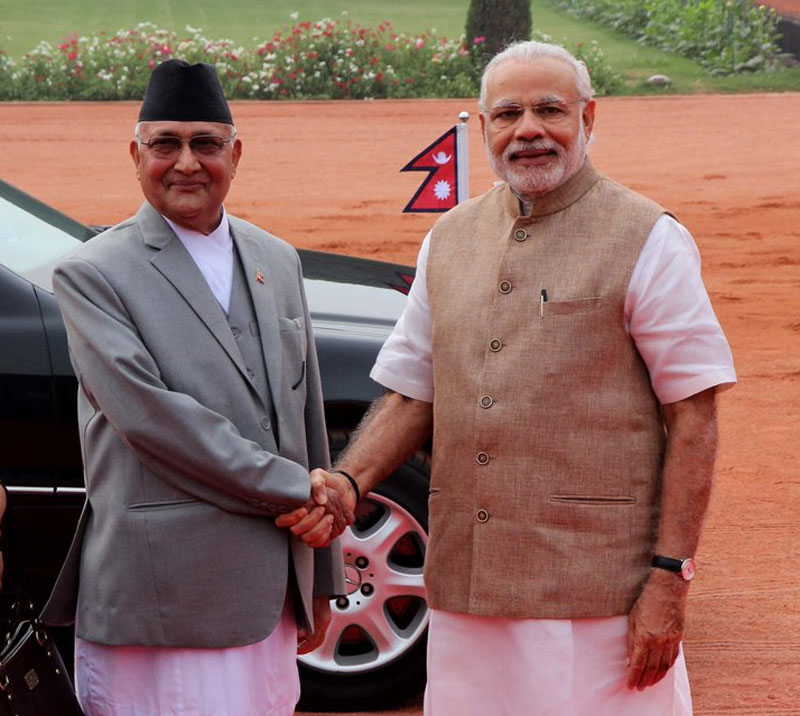By Prakash Katoch (13 April 2018) – Nepalese prime minister KP Sharma Oli’s recent India visit is being hailed as a new leaf in India-Nepalese relations; it was more about rebuilding trust. China’s Xinhua quoted Oli as saying after his visit, “Nepal and India are two sovereign countries and good friends. We want to develop goodwill and mutual trust according to the change of times. I believe that my visit was productive to building mutual trust and friendship between the two countries.”
Returning to Nepal after his India visit, Oli remarked at the airport in Kathmandu, “I conveyed the top Indian political leadership that Nepal wants to develop a relationship with India and our neighbours in line with the changing times in this 21st Century. I found they were quite positive in my opinion.”
During Oli’s visit, construction of the Motihari-Amlekhgunj petroleum products pipeline was flagged off, besides an agreement on the new railway line from Raxaual in Bihar to Kathmandu, integrated border checkpoints, organic agriculture, and inland waterways – the latter just an initial idea which will need much reconnaissance and follow up. The two sides also agreed to speed up the India-funded development projects in Nepal, including the Pancheswar Multipurpose Project.
India has traditionally been blamed for lacking strategic sense. Former foreign secretary Kapil Sibal had said, “That we produced Chanakya almost 2400 years ago is not sufficient ground to claim that today’s India possesses a strategic culture.”
Ironically, you also have diplomats stating that the India-Nepal border is the only “open border”; oblivious that the India-Myanmar border is also open. But while Oli may mention the “changing times in this 21st Century” in a different context, India will do well to examine the threat via Nepal, which is far greater than an open admission of “full support” to Naxals in India by Nepal’s Maoists.
Mao Zedong had said, “Tibet is the palm of China and Ladakh, Nepal, Sikkim, Bhutan and NEFA (Arunachal Pradesh) its fingers.” China, it seems, thinks 100 years ahead. The Chinese ministry of foreign liaison under Mao had recruited and supported Maoist groups in Nepal, Burma, Philippines, Peru, the Japanese Red Army, and the Shining Path in Peru.
Chinese intelligence infiltration operations into Nepal, that began decades ago, set off a self-perpetuating Maoist “People’s War” that has never really ended. Thus, it is in China’s interests to install a regime in Kathmandu that is not too friendly with the US or India.
Much before Pushpa Kamal Dahal, alias Prachanda, became prime minister of Nepal, he had told Nepalese media, “The ultimate war will be with the Indian Army”, which can hardly be construed a political statement, even as Nepal’s moves to stop Nepalese Gurkhas from joining Indian Army may be given the benefit of the doubt. But Maoists’ takeover of Nepal underscores the success of Communist China, which has consistently applied its hard and soft power in Nepal.
India and Nepal have ancient and historical links. Indian and Nepalese armies enjoy excellent relations and Nepal should logically not like its territory to be used for anti-India activities. But China, together with its protégé Pakistan, is past master in playing the sub-conventional card.
Take the case of Myanmar, where China has created proxies in the 10,000-strong United Wa State Army (USWA), armed with missile-fitted Chinese helicopters, and the United Liberation Front of West, South East Asia (ULFWSEA) as means to pressure both India and Myanmar.
The Indian Army has been conducting bilateral joint exercises with Nepal, Myanmar and China, but that does not deter Beijing from pursuing its nefarious agenda. Remember a few years back, media reported that four Chinese nationals were caught with fake Indian documents en-route to meet Naga rebels; which perhaps led to NSCN (K) abrogating its 14-year-old ceasefire with the Indian Government.
Chinese are past masters in pushing their anti-India agenda via Nepal in a manner that Oli can do little about – just like in Myanmar. Integrated border check-posts (still a long way off) can only help if movement other than these posts is met with force, which is unlikely with occasional patrolling. Nepal deploying drones along the border, which will obviously be Chinese, can also be used for infiltration of terrorists, arms, narcotics and drugs – in line with China’s concept of ‘Unrestricted Warfare’.
It will be foolish to believe that China will forsake its illegal territorial claims because of connectivity and economics (OBOR); its recent protests against purported Indian ‘transgressions’ in Asaphila should make this clear.
China’s occupation of north Doka La, construction of a road and posts in Shaksgam Valleymust be viewed in concert with the threat to the Siliguri Corridor.
Pakistani prime minister Shahid Khaqan Abbasi’s visit to Nepal in early March too must be seen in the context of not only a well-oiled network in Nepal, giving protection to ISI-backed terrorists, but becoming a “Control Centre”, as per the IB, which the China-Pakistan anti-India nexus is liable to exploit, supported by Nepalese Maoists.
Earlier, ISI-backed terrorists had allegedly transited Nepal to sabotage India’s trains and railway network, but now it may be for much more. Eminent scholar and China-watcher Claude Arpi wrote in 2014 of ‘PLA soldiers in uniform deployed in Northern Nepal’ in 2014. Nepal’s agreement permitting Chinese oil drilling in Terai region will bring the PLA to Terai, which is already infested with ISI-backed radicals.
Ironically, such acts will likely be supported by Naxals frequenting visiting Beijing. India must also watch out for Bhutanese refugees in Nepal, headed by a former officer of the Royal Bhutan Army, which China may exploit to pressure Bhutan and India – Oli being a pawn or complicit. These are clear and present dangers, which India can ignore only at its peril.
The author is former Lieutenant General. This article first appeared in firstpost.com



